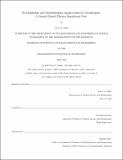| dc.contributor.advisor | Areg Danagoulian. | en_US |
| dc.contributor.author | Miske, Jacob N. | en_US |
| dc.contributor.other | Massachusetts Institute of Technology. Department of Nuclear Science and Engineering. | en_US |
| dc.date.accessioned | 2020-09-15T21:51:24Z | |
| dc.date.available | 2020-09-15T21:51:24Z | |
| dc.date.copyright | 2020 | en_US |
| dc.date.issued | 2020 | en_US |
| dc.identifier.uri | https://hdl.handle.net/1721.1/127307 | |
| dc.description | Thesis: S.B., Massachusetts Institute of Technology, Department of Nuclear Science and Engineering, May, 2020 | en_US |
| dc.description | Cataloged from the official PDF of thesis. | en_US |
| dc.description | Includes bibliographical references (page 36). | en_US |
| dc.description.abstract | Current particle physics simulations take place largely within small communities developing limited tools for specific areas of study. These particle simulations are essential to evaluating environments outside of the realm of experimentation in the radiation sciences. While multi-use toolkits exist for particles simulation (such as the popular MCNP or SRIM programs), these computational tools are often difficult for untrained users to adapt into their projects. Geant4 is one such toolkit that is used widely by physicists in radiology, fission reactor work, and space irradiation studies among many other fields. As it happens, Geant4 and related programming libraries are not the default program to install and use for scientific simulations by physicists or the general public interested in this work. However, a widely applicable simulation engine using Geant4, called Grasshopper, has been developed to allow for generating straightforward Monte Carlo simulations for engineers and scientists in a wide range of fields. This thesis evaluates Grasshopper with a series of benchmarks that show the software is able to accurately match empirical results. These benchmarks evaluate the accuracy of Grasshopper to run simulations involving alpha, proton, beta, gamma, and neutron radiation in the range of 1 MeV to beyond 100 MeV. By allowing users of Geant4 to easily generate these simulations, the time it takes to develop insights can now be reduced further with the increased efficiency from the use of these tools. | en_US |
| dc.description.statementofresponsibility | by Jacob N. Miske. | en_US |
| dc.format.extent | 39 pages | en_US |
| dc.language.iso | eng | en_US |
| dc.publisher | Massachusetts Institute of Technology | en_US |
| dc.rights | MIT theses may be protected by copyright. Please reuse MIT thesis content according to the MIT Libraries Permissions Policy, which is available through the URL provided. | en_US |
| dc.rights.uri | http://dspace.mit.edu/handle/1721.1/7582 | en_US |
| dc.subject | Nuclear Science and Engineering. | en_US |
| dc.title | Developments and benchmarking applications for Grasshopper : a Geant4 based physics simulation tool | en_US |
| dc.type | Thesis | en_US |
| dc.description.degree | S.B. | en_US |
| dc.contributor.department | Massachusetts Institute of Technology. Department of Nuclear Science and Engineering | en_US |
| dc.identifier.oclc | 1191904092 | en_US |
| dc.description.collection | S.B. Massachusetts Institute of Technology, Department of Nuclear Science and Engineering | en_US |
| dspace.imported | 2020-09-15T21:51:23Z | en_US |
| mit.thesis.degree | Bachelor | en_US |
| mit.thesis.department | NucEng | en_US |

